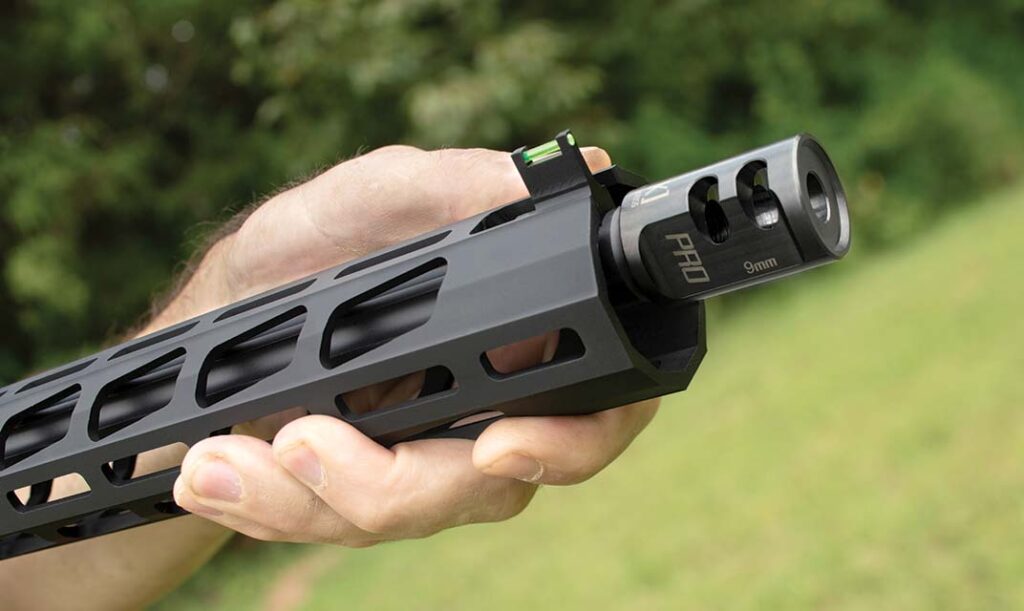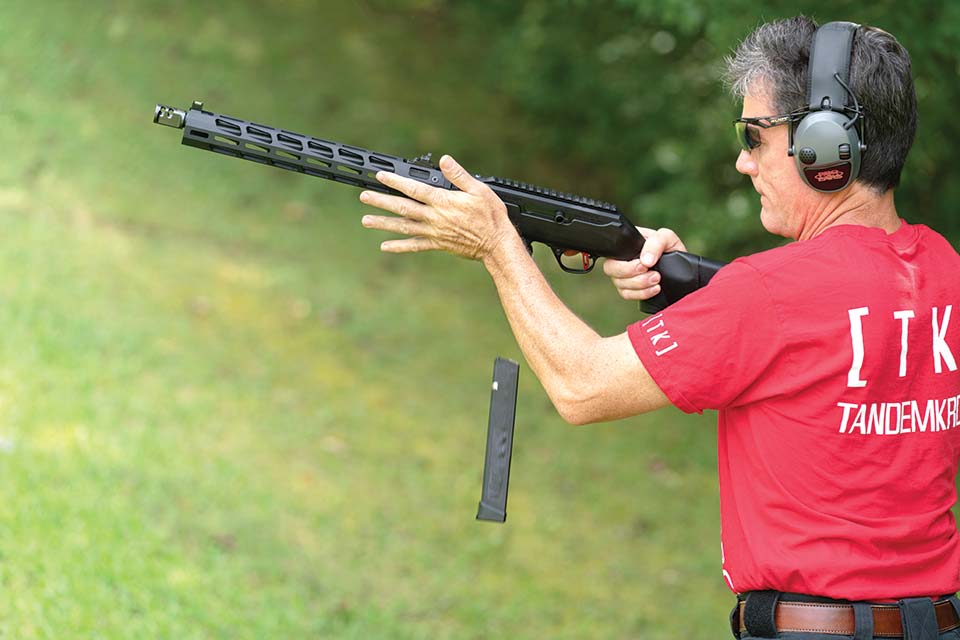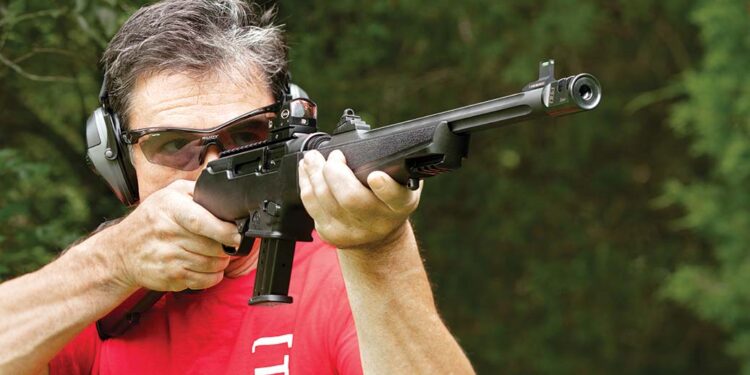Story & Photography by Oleg Volk
The Ruger PC 9mm Carbine in its multiple iterations has gained a well-deserved popularity almost instantly. Reliable, accurate, ergonomic, compatible with Ruger or GLOCK magazines, and a take-down design on top of all that, it is a massive improvement on the old 1996 PC 9mm in every regard. With this positive introduction, we might wonder what’s left for the aftermarket producers to offer. The answer lies in the special-purpose use in which the new PC has been employed: competition shooting.
TANDEMKROSS (TK), a New Hampshire company specializing in parts for sport shooting, came out with several improvements for the Ruger PC, all focused on improving speed and precision. These changes aren’t intended for defensive use, though some would benefit a “Roof Korean” as much as it would a sporting competitor.

In its basic form, the carbine is a plain blowback 9mm weapon that takes Ruger pistol magazines. It’s offered with a variety of stocks and forends. Being a take-down, it permits mixing and matching front and back ends to create a wide variety of configurations. In its basic form with a synthetic forend and fixed plastic stock, it weighs 6.7 pounds but feels lighter thanks to the good balance. A PPSh-like, free-floated M-LOK aluminum forend brings the weight up to 7 pounds, with the subjective feel of much greater heft. Another third of a pound provides the option of a folding telestock. Everything about this gun and its variations is robust and solid. The rear sight comes with an open notch and ghost ring options; the front sight is a post heavily protected by steel wings. The charging handle and the magazine release are reversible. The standard forend has a short rail at the bottom for a light, the free-float rail has M-LOK slots all over. What can be improved for speed shooting?
The front sight is the first part: replacing the busy three-blade sight picture with one clear post topped with a thin fiber optic pipe speeds up the sight acquisition and adds precision. Even though the peep rear sight is placed too far forward to be a true ghost ring, adding the fiber optic makes it work better than the rear V notch. The glowing red or green dot is quicker to center than the flat top of the post just above it. This sight upgrade works great for sports, but it’s completely unprotected and so not ideal for the potential rough and tumble of fighting. Using a T10 Torx wrench and a couple of minutes suffice for the installation. Since the time I tested this sight, TK has come out with a fiber optic rear sight for the PC. By putting rear light pipes at the same offset from the metal sight as in the front, TK made the notch and post sight picture as quick to acquire as the ghost ring.

The “Victory” trigger is next up: the Ruger original is adequate, but the textured TANDEMKROSS part improved tactile feedback, also permitting a lower fingertip placement for greater leverage. As a result, the weight of the pull stays constant, but it feels lighter to the user. A built-in over-travel adjustment helps with maintaining shorter splits between shots. This enhancement belongs on sporting and combat guns alike. The replacement process requires a 5/32-inch Allen wrench and a pinch for removing pins, along with a few minutes for the swap.
The original magazine release is excellent for a fighting rifle: it’s textured for non-slip contact and fenced again. For a rapid magazine change, a free-standing wide mag release that can be just slapped instead of pressed is quicker. The textured red or white anodized, oversized Titan button from TK does the job well. A 5/64-inch Allen wrench and a couple of minutes get it installed. Again, it’s not for field use, rather for the gun games in which every second counts but slung carry doesn’t happen.

With the fixed Ruger stock having considerable drop, the shooter gets the benefit of the minimal sight offset from the bore, an advantage for accuracy up close. The same drop stock provides additional torque on the rifle during firing, causing greater muzzle rise than an AR-15 of the same caliber would have. While the aluminum forend helps with that a little by shifting the overall balance forward, the cleverly designed TK “Game Changer PRO” compensator does the same job dynamically. Adding only 2 ounces over the standard thread protector, this brake is very effective at negating muzzle rise without much added concussion. The muzzle flash is minimal, and the powder fumes are re-directed to the sides and away from the sight picture. Installing it is simple, but this does require timing the ports. A similar design made for rimfire guns is quite effective, so it’s no surprise that the 9mm variant that has more gas to work with does an excellent job. The key to its success is concentrating on the rise compensation and not trying for the unnecessary braking effect.
With all of these parts, TANDEMKROSS provides detailed pictorial and video installation instructions. Since the time my carbine was configured, they also added two variants of upgraded charging handles, the conical “Challenger” and the skeletonized hooked “Spartan” as alternatives to the less grippy cylindrical original part. For the lowest possible sight height over bore, TK is also offering a “Shadow” direct mount plate for micro red dot sights, to bypass the Picatinny rail on top. This plate replaces the rear sight. Finally, they have a complete, extensively adjustable “UPRISER” PC stock: it goes beyond the scope of my review, but it’s worth investigating on their website.

With all these changes and adjustments made to the two test carbines, how much did it change handling and efficiency? The same 35-round course of fire with one magazine change, consisting of three full-size silhouettes and two small plates at distances between 12 and 30 yards, could be shot in about 30 seconds compared to 40 seconds with the original configuration. The hits also were more centered. The advantage in speed was retained once red dot sights were added, with the course of fire approximating 25 and 35 seconds, respectively. Between two competitive shooters of similar skill level, the one with the upgrades would win by a wide margin. The difference in handling was especially pronounced with gloves on, as the larger, more fault-tolerant mag release button guaranteed a reliable magazine swap.
| This article first appeared in Small Arms Review V24N8 (Oct 2020) |












